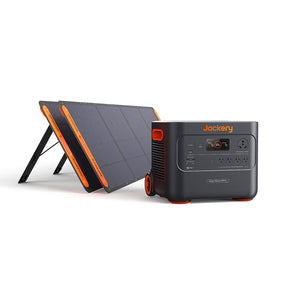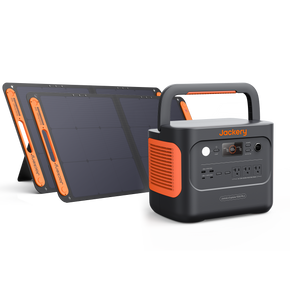How To Read Solar Panels Specifications
Solar panels are getting a lot of hype, and many homeowners are investing hundreds of dollars in clean and renewable energy sources. However, reviewing solar panel specifications is of utmost importance to ensure you understand where you’re investing your hard-earned money.
For instance, Jackery SolarSaga 200W Solar Panels are built with highly efficient solar cells. These panels are lightweight, portable, and foldable, having a conversion efficiency of 24.3%. You can connect these solar panels with Jackery Explorer 2000 Pro Portable Power Station to power home or outdoor appliances using the sun’s energy.
|
Jackery SolarSaga 200W |
 |
|
- Higher conversion efficiency of up to 24.3%. - IP67 waterproof rating to withstand harsh and wet weather. - 23.2V of Open Circuit Voltage and 11.76A of Short Circuit Current - 6*SolarSaga 200W Solar Panels can charge Jackery Explorer 2000 Pro in 2.5 hours. - Built with an ETFE-laminated case to ensure a long lifespan and high durability. |
In this solar panel specifications guide, we will learn how to read solar panel specifications, like open circuit voltage, wattage, short circuit current, etc., and choose the right panels.
What Are Solar Panels Specifications?
The solar panel specifications sheet includes electric ratings, technical jargon, and many other parameters that determine the efficiency of the solar panel. Usually, you can find the technical specifications of solar panels on the manufacturer’s website.
Before we dig deep into the electrical terms related to solar panels, understanding the difference between solar cells and solar modules is vital. A solar cell is typically 125mm × 125 mm or 156 mm × 156 mm sized silicon wafers combined to form solar modules.
When 60, 72, or 96 solar cells are wired together, they form a solar panel or solar module. Large-size solar panels are suitable for commercial purposes, while small-size panels are best suited for residential applications.
Solar Panel Test Conditions
Commonly, there are two test conditions for solar panels, including:
Standard Test Conditions (STC)
STC is the set criteria for testing the solar panels. As current and voltage are based on light intensity and temperature, all solar panels are tested under the same conditions. In this case, the solar cell temperature is 25°C with a light intensity of 1000 watts per square meter.
Normal Operating Cell Temperature (NOCT)
Unlike STC, NOCT focuses more on realistic conditions. Instead of a light intensity of 1000 watts per square meter, the solar panel intensity is set at 800 watts per square meter. Additionally, it uses an air temperature of 20°C with 1 m/s wind velocity. Though these ratings are lower than STCs, they are much more realistic.
How to Read Solar Panel Specifications?
When it comes to reading the solar panel specifications, you will need to understand all the essential electrical terms. Below we have included all the common electrical terms associated with solar panels.
Wattage on Solar Panel: Wattage means the electrical output produced by the solar panels under standard test conditions. The higher the wattage of the solar panels, the more electricity they can produce in the same time frame.
Open Circuit Voltage (Voc): It represents the maximum voltage of a solar panel when no load is connected to it. Voc will help you determine the number of solar panels you can wire in series without overvoltage or overcurrent issues.
Short Circuit Current (Isc): It is the highest current produced by the solar panel when no load is connected. It helps you estimate how many amps a connected device can handle. In this case, users need to ensure that the plus and minus of the solar panels are connected to each other.
Maximum Power Point (Pmax): It’s the point where a combination of amps and volts results in the highest watts. The MPPT charge controller maximizes the solar panel output by keeping the volts and amps at Pmax or Maximum Power Point.
Maximum Power Point Voltage (Vmpp): The Vmpp determines the point where the power output of the solar panels is greatest. When the solar panels are connected to the MPPT solar charge controller or an inverter under STC, the voltage you see is Vmpp.
Maximum Power Point Current (Impp): The current produced when there is high power output is termed Impp. You can see the Impp when solar panels are connected to the MPPT controller under STC.
Nominal Voltage: It’s not the actual voltage you will measure, but it is a category that lets you define which equipment goes together with the solar panels.
Power Tolerance: It measures the power solar panels produce below or beyond their rated capacity.
Module efficiency (%): It measures how much sunlight hitting the solar panels is converted into electrical energy.
Warranties: Solar panel specifications also mention the warranties. However, they may vary depending on the manufacturer and the quality of the panels.
Temperature Coefficient: It represents the relationship between PV output and solar panel temperature. The temperature coefficient determines the overall percentage decrease in power for each degree of rise in temperature.

Jackery Solar Panel Specifications
Choosing the right solar panels that are highly efficient, portable, and built with quality materials is not an easy feat. That’s why Jackery brings the finest range of solar panels and portable power stations. Jackery solar panels are capable of performing in hot and cold weather. Each time the temperature rises by 1℃, the solar panels will still work with a high solar conversion energy compared to other panels available in the market.
Jackery SolarSaga Solar Panels are built using water and dust-resistant materials, making them ideal for extreme outdoor conditions. The high wattage capacity and solar efficiency ensure solar panels convert maximum sunlight into electricity. You can combine solar panels with Jackery Explorer Portable Power Stations to charge different home or outdoor appliances. Below are the popular Jackery SolarSaga Solar Panels available on the market.
Jackery SolarSaga 200W Solar Panels
The advanced solar cells in Jackery SolarSaga 200W Solar Panels offer a high conversion rating of 24.3%. The IP67 waterproof rating, 23.2V open circuit voltage, and 11.76A short circuit current value make it fit to power a high-capacity battery in less time. It comes with a practical, easy-to-carry bag that makes it an ideal powering solution for off-grid adventurers.

|
Technical Parameters |
Value |
|
Peak Power |
200W |
|
Power Voltage |
19V |
|
Power Current |
10.53A |
|
Open Circuit Voltage |
24.2V |
|
Short Circuit Current |
10.8A |
|
Operating Temperature Range |
-10-65℃(14-149°F) |
|
Dimensions (Unfolded) |
540 × 2355 × 25mm |
|
Dimensions (Folded) |
540 × 625 ×44mm |
Jackery SolarSaga 100W Solar Panels
Next on the list is Jackery SolarSaga 100W Solar Panels, with high solar efficiency of 24.3%. The open circuit voltage of solar panels is around 21.6V with a short circuit current of 6A. It can produce a power output of 100W with a power current of 5.55A and a power voltage of 18V. The water-resistant capabilities of solar panels increase their lifespan and make them highly durable. One of the best features of Jackery SolarSaga 100W Solar Panels is that it is compact in size. You can carry solar panels and a portable power station to charge your outdoor gear.

|
Technical Parameters |
Values |
|
Peak Power |
100W |
|
Cell Efficiency |
24.3% |
|
Power Voltage |
18V |
|
Power Current |
5.55A |
|
Open Circuit Voltage |
21.6V |
|
Short Circuit Current |
6.1A |
|
USB-A Output |
5V, 2.4A |
|
USB-C Output |
5V, 3A |
|
Operating Temperature Range |
-10-65℃(14-149°F) |
|
Dimensions (Unfolded) |
1220 × 535 × 5 mm |
|
Dimensions (Folded) |
610 × 535 × 35 mm |
Jackery SolarSaga 80W Solar Panels
These are dual-sided panels with a solar conversion efficiency of 25%. The upgraded solar panels are IP68 waterproof and dustproof certified to provide protection against harsh weather conditions. The peak power produced by the solar panels is 80W with a power voltage of 22V and a power current of 3.6V. The solar panel is compatible with all the Jackery Explorer Portable Power Stations, making it easy for you to choose the right size solar generator.

|
Technical Parameters |
Values |
|
Peak Power |
80W |
|
Working Voltage |
22V/3.64A |
|
Open Circuit Voltage |
28.5V/3.71A |
|
Weight |
Product weight: 5.1 kg With carrying case: 6.5 kg |
|
Dimension |
90.6 × 52.8 × 2.7 cm |
|
Accessories |
1*2-meter extension cable, 1*user manual, 1*carrying case for solar panel |
|
Operating Temperature Range |
-10-65℃(14-149°F) |
|
Connector Type |
DC8020 2m extension cable with DC8020 to DC7909 connector |
Solar Panel Material Characteristics
Based on the electrical ratings and parameters, the solar panel specifications differ depending on the material used in its manufacturing.
Solar Cell & Types
The most common cell types used in solar panels are monocrystalline and polycrystalline silicon cells. However, the former is highly preferred as they are made of a single silicon cell structure rather than multiple silicon cells.
Dimensions
Solar panel dimensions vary depending on the number of cells used. For example, 60-cell solar cells are used in residential areas, whereas larger ones, like 72-cell and 96-cell solar panels, are preferred in commercial spaces.
Wind and Snow Loads
Next, you need to pay attention to the wind and snow loads of solar panels. The high mechanical or static load ratings of the module ensure that the panels can withstand harsh winds and can stand well against all the elements.
Solar Panel Specifications FAQs
What are solar panel warranties?
The warranties on the solar panel differ depending on the manufacturer. For instance, Jackery offers high-quality SolarSaga Solar Panels that come with a 5-year warranty. Buyers get a 3-year warranty on regular purchases, with an additional 2-year warranty extension when ordering from the official website.
How to choose a solar panel?
While making the purchase, you will need to understand the solar panel’s specifications. Below we’ve mentioned some of the most important things you will need to look out for while selecting solar panels.
- Check the solar panel efficiency to ensure it can convert the maximum amount of sunlight that hits the surface into electricity.
- The temperature coefficient of the solar panels should be low to ensure they don’t age faster and convert sunlight into electricity faster.
- Compared to polycrystalline and amorphous solar panels, monocrystalline panels are highly efficient. Therefore, it’s a wise idea to invest in monocrystalline panels with longer lifespans.
Are solar panels worth it?
Solar panels are an excellent way to reduce carbon footprint and protect the planet. You can connect the solar panels to a portable power station to charge a wide range of appliances using free solar energy. However, not all solar systems are the same. You can consider investing in the Jackery Solar Generators, which are robust and powerful charging solutions available on the market. You can power most of your home or outdoor appliances with the high battery capacity Jackery Explorer Portable Power Stations and SolarSaga Solar Panels.

Final Thoughts
Investing in high-quality solar panels involves understanding the key performance metrics and specifications. For instance, if you have limited space, checking the solar panel specifications, like wattage and efficiency, is vital to understand how much electricity it will produce.
On the other hand, low-temperature coefficient solar panels will help you mitigate the heat effects of the hot weather.
Jackery Solar Generators are built with high-quality materials. Jackery SolarSaga Solar Panels have high wattage and efficiency, ensuring you can convert the maximum amount of sunlight into electricity. Furthermore, they come with a 5-year long warranty, ensuring you can harness the power of free energy for years.
















































































































































Leave a comment